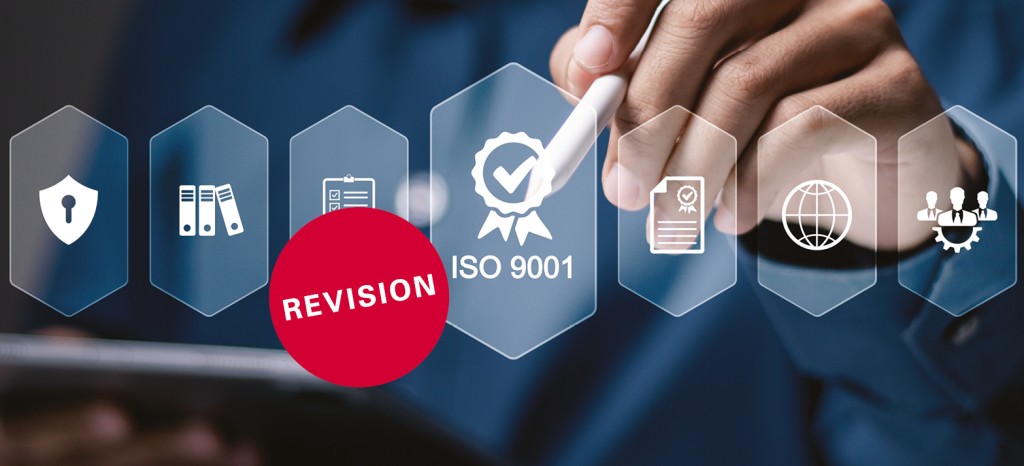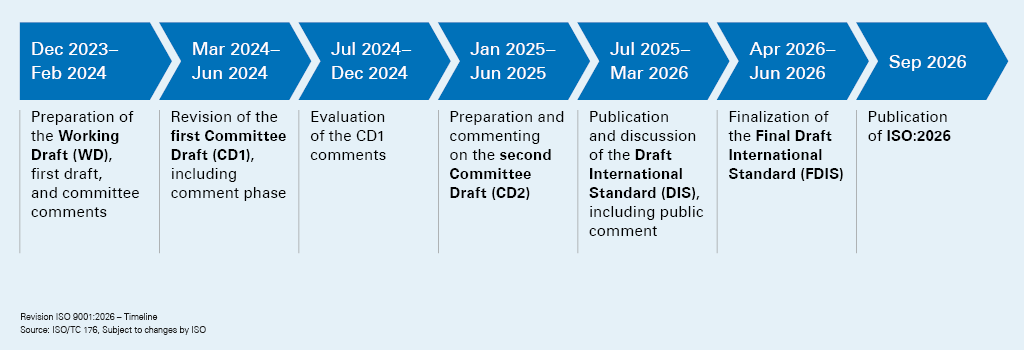The revision of ISO 9001 – Everything you need to know now!


Important to know
In summer 2023, the ISO Technical Committee ISO/TC 176 SC 2 decided to revise ISO 9001:2015. It is now confirmed that the new version will be published in 2026. We will explain which changes are planned, what impact the updates will have on companies, and how you can best prepare for them.
About ISO 9001: Established Quality Management Since 1987
Since its introduction in 1987, the ISO 900X series has proven to be an effective management tool in both industry and the service sector. The certification is suitable for companies of all sizes and industries. It signals reliability, meets customer requirements, and provides a crucial competitive advantage - especially in acquiring new customers and in tender processes.
The benefits of a Modern Quality Management System with ISO 9001
Competitive advantages at a glance:
- Increased customer satisfaction
- Access to new markets
- Process optimization
- Risk reduction through compliance with legal requirements
An effective and efficient management system in accordance with ISO 9001 is characterized by clear objectives, measurable results, adequate resources, and structured processes. The new revision will place even greater emphasis on these elements and support organizations in their ongoing improvement efforts.
Our expert Lukas provides answers to the most important questions about the ISO 9001 revision
What exactly changes with ISO 9001:Revision 2026?
- Expanded responsibilities
- Focus on risks and opportunities:
Potential improvements will be analyzed more thoroughly. - The revision of the standard follows the Harmonized Structure (HS).
The HS is a further development of the High-Level Structure (HLS), on which the standard was previously based. This ensures that ISO 9001 remains compatible with other ISO management systems, such as ISO 14001 or ISO 45001.
How to prepare your company for the ISO 9001 revision
Transitioning to the new ISO 9001 becomes easier if you inform yourself early and plan the necessary adjustments. The simplest approach is to build on your current ISO 9001 system. So don’t wait, even if you are not yet certified – this allows you to use the three-year transition period efficiently and quickly stay up to date.
Conclusion: Your opportunities with the new ISO 9001
The ISO 9001 revision offers companies a great opportunity to further develop their quality management systems and secure competitive advantages. Take the chance to review your structures and plan for future requirements now. Whether in highly regulated industries, with service providers, in educational institutions, or in public administration – the revised standard will significantly influence how organizations manage their processes, shape their quality culture, and remain competitive in the long term.
To help you better understand the phases, here is a brief explanation of the respective draft stages:
- Working Draft (WD): Internal working draft within the committee (serves as a rough content orientation)
- Committee Draft (CD): First publicly visible drafts, which are commented on within the ISO committees
- Draft International Standard (DIS): Mature draft version, also released for public commenting – for the first time allowing broader participation
- Final Draft International Standard (FDIS): Nearly final version for voting without content changes – only final editorial adjustments
- International Standard (IS): Final publication by ISO – serves as the basis for certifications
Here are the most important questions and answers for you to review.
We also warmly invite you to register for one of our TÜV Rheinland training courses on the ISO 9001 revision – either virtually or on-site at one of our training centers. You can find an overview of the dates and details on how to register here: Quality Management Trainings | TÜV Rheinland Academy
ISO 9001 Training Opportunities Across the Globe
Contact






